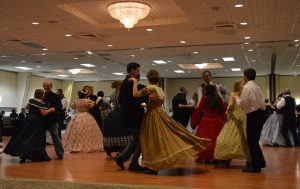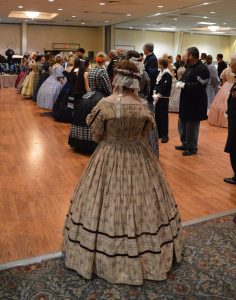Civil War Ball raises funds for Gettysburg National Military Park
Dancers prepared for the Grand March at the Original Civil War Ball. (Anthony C. Hayes)
During the American Civil War, elegant balls were often held as charitable events to support an array of worthy causes. Many will recall the rousing scene of one such fictional occasion, beautifully played out in the 1939 film Gone With The Wind.
The conviviality of such soirees undoubtedly encouraged generosity, but the dances also served as a painful reminder of the mounting costs of the war. Approximately 625,000 soldiers died from sickness and injuries during the conflict. In terms of our present population, that would be equivalent to losing six and half million men.
Honoring the sacrifice of those who died, while emulating the spirit of generosity from that bygone era, the Sons of Veterans Reserve (SVR) hosted its annual Original Civil War Ball last Saturday night in Gettysburg.

The gala ball was held in the Robert E. Lee room of the Eisenhower Hotel.
Authentic Civil War-era music was provided by the Philadelphia Brigade Band, with more than a dozen popular period dances led by the Victorian Dance Ensemble – a non-profit which raises money for various Civil War-themed charities around the country.
One of several such festive events held around Gettysburg to fête the faithful for Remembrance Day, the Original Civil War Ball attracted some 250 dance enthusiasts. Proceeds from the ball were donated to the Gettysburg National Military Park – primarily for use in monument preservation.
Members of both Union and Confederate hereditary groups were in attendance at the ball, as were civilian and military reenactors, and other supporters of Civil War historical preservation.
While waiting in line at the hotel, we struck up a conversation with Frank Hilliard – a member of the Custer Memorial Association in Jewett, Ohio.

Though best remembered for his fatal decisions at the Battle of the Little Big Horn, it was Custer’s spirited leadership of the Michigan Brigade against the superior cavalry of Confederate J.E.B. Stuart, which helped secure the victory for Union forces at the Battle of Gettysburg.
“Because of the Michigan Brigade and his wife Libbie, most people think Custer was from Monroe, Michigan, but he was actually born in New Rumley, Ohio,” explained Hilliard. “There is a monument to Custer in New Rumley, which isn’t far from where we are in Jewett. We hold events around the area throughout the year.” Interestingly, the next scheduled event is a December 9 birthday observance program, titled: “Custer at Gettysburg.”
Hilliard decided to sit out most of the dancing, saying he’d spent a lot of time on his feet as a cook in the Army. But others where eager to hit the dance floor for an evening of exhilarating fun.
Ladies and Gentlemen, choose your partners!
Entering the ballroom, everyone was given a dance card for the event. The three-set card included a variety of waltzes, reels, quadrilles and polkas.
Though admittedly a quaint nod to the 19th Century, dance cards have a fascinating history. In times past, a carefully enumerated card could not only help a popular woman keep track of her dance-floor commitments, it might also stay deadly duels between the woman’s jealous suitors over the true nature of her affection.
For those who have never attended a Civil War ball, one question which seems to emerge is how did women move about so effortlessly in those huge hoop skirts? I was told, matter-of-factually, “It is something you just get used to.” That may be the case, but it couldn’t hurt that a number of women could be seen wearing sneakers and yoga pants beneath the billowing hems of their beautiful ball gowns.
Every dance was carefully demonstrated by members of the Victorian Dance Ensemble, who then joined the smaller groups of novices to ensure fluidity for the frolicsome affair.

The most popular dances of the night appeared to be the quadrilles (Lancer’s and Empire) and the reels (Snowball and Virginia). The former consists of four couples moving about in a compass-like formation – while the latter pits partners face-to-face along an opposing line.
The waltzes moved rather elegantly – even if some could be overheard counting out the steps. Then there were the strange three-person dances – originally necessitated by the toll of the war.
“One thing I always found interesting and rather sad about the Civil War era balls,” says Maryland-based dance instructor Laura Gibson, “is the number of three-person dances developed during this period; using one man and two women per group because of the lack of men and excess of ladies during the Civil War. I always think how sad afterwards for so many who lost sweethearts and husbands so young. The fear of spinsterhood or not finding a desirable partner – especially during this time of unrest – was quite real and frightening.”
As a charitable affair, we were curios how much money these events have raised over the years. Brig. Gen. Henry Shaw, of the SVR, happily provided the answer.
“On Monday I mailed a check in the amount of $2,000.00 to Charles Hunt, the Acting Superintendent of the Gettysburg National Military Park (GNMP.) That sum brings the donations from the SVR to GNMP to a grand total of $84,500.00.”
Shaw said that writing the latest check to the GNMP has effectively cleaned out the kitty – but that’s all right. The group is already looking ahead to next year’s ball. And so am I.
Any excuse to wear my frock coat.


Anthony C. Hayes is an actor, author, raconteur, rapscallion and bon vivant. A one-time newsboy for the Evening Sun and professional presence at the Washington Herald, Tony’s poetry, photography, humor, and prose have also been featured in Smile, Hon, You’re in Baltimore!, Destination Maryland, Magic Octopus Magazine, Los Angeles Post-Examiner, Voice of Baltimore, SmartCEO, Alvarez Fiction, and Tales of Blood and Roses. If you notice that his work has been purloined, please let him know. As the Good Book says, “Thou shalt not steal.”

